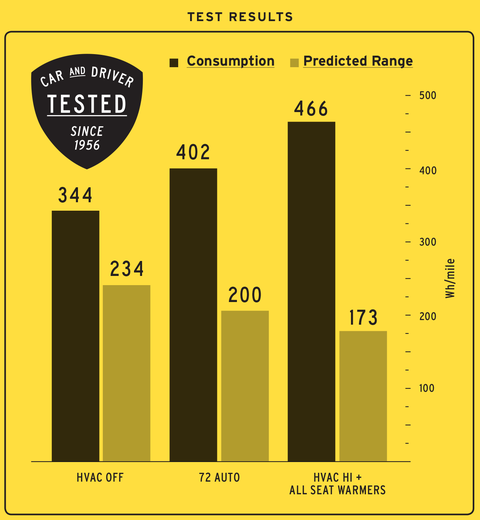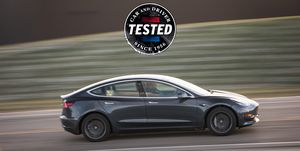
Michael SimariCar and Driver
- How much does climate control, specifically heat, affect range?
- We took our long-term Tesla Model 3 to the Chrysler Proving Grounds’ five-mile oval track to test energy consumption with various levels of HVAC usage.
- With the seat warmers on and the heat on full blast, the Tesla lost over 60 miles of range compared to the figure we recorded with no HVAC use.
In Michigan, winter hasn’t quite loosened its grip yet, holding on to the cold and cloudy skies like a curmudgeonly old man. Naturally, our first instinct when we climb into a cold car is to crank up the heat. However, in electric vehicles, such as our long-term Model 3 Long Range, turning on the heat can’t be an afterthought, because it dramatically impacts efficiency and range.
Heating or air conditioning is a big deal in an electric vehicle, for two reasons: First, the total amount of energy onboard is dramatically less than what’s available in a typical gasoline car. Every bit of energy used has a more noticeable impact on range. For example, a 15-gallon gas tank holds the equivalent of 505.5 kilowatt-hours (kWh) of energy. That’s more than six times what our Model 3 carries fully charged. The second reason is that, unlike in a gasoline-fueled car, where waste heat from the engine is used to heat the cabin with little impact on efficiency, an EV’s heat or A/C is also drawing directly from the battery. Any energy used for comfort can’t be used for propulsion.
How much does running the heat really affect the Tesla’s range? To find out, we went to the five-mile oval at the Chrysler Proving Grounds, which allows us to gather data without interference from things like elevation change and traffic–the real world obstacles to testing.
To see how the use of heat would affect range, we decided to run three tests at 70 mph: with HVAC off, set to 72 degrees Fahrenheit on auto (the same as our highway fuel-economy test protocol), and with the HVAC on full blast while all five of the heated seats were set on HI. We did two laps around the oval in each condition to let the onboard consumption meter settle in on a steady average watt-hours per mile (Wh/mile) figure. Our tests were performed at a temperature of 38 degrees Fahrenheit, on Michelin X-Ice Xi3 winter tires set to the factory setting of 42 psi. Winter tires tend to have higher rolling resistance, so the efficiency figures on the stock all-season Michelin Primacy MXM4 tires would likely improve across the board. The Model 3 had been driven for roughly a half-hour and was fully up to temperature and the cabin was warm before we started this test. Starting with a cold motor and battery would increase consumption even further.
Our baseline consumption with the HVAC turned off completely was 344 Wh/mile, which implies a possible range of 234 miles. Our second round was with the climate set to 72 degrees and on automatic, where the Model 3 consumed energy at a rate of 402 Wh/mile, just a tick below 17 percent more energy than the run without HVAC. At that rate of consumption, the predicted range falls to 200 miles. For our final test, with the heat all the way up and the seat heaters on—if you like to carpool in the winter, this number is for you—we measured a whopping 466 Wh/mi, which greatly exceeded even the highest number we got in our aero wheel cover test, and that was on all-season tires traveling at 90 mph. With the heat blasting at that rate you could expect your range to drop to a meager 173 miles by consuming about 35 percent more energy than our baseline run.
The Model 3 uses a resistive electric heater (essentially like the glowing coils in a toaster), which is far cheaper, but not as efficient as a heat pump. A heat pump is like running the air-conditioning system in reverse. However, heat pumps are starting to become available in more and more EVs, including the Nissan Leaf, the Kia Niro EV, the Audi e-tron, and the Jaguar I-Pace. The just-launching Tesla Model Y has also switched to a heat pump, and we’ll be interested to see how efficient it proves to be in cold temperatures.
Whether you’re making your rounds through the Arctic tundra you call home or you live in Florida and consider 50 degrees Fahrenheit to be chilly, keep in mind that everything you do costs energy from your battery pack.
Source: Motor - aranddriver.com







